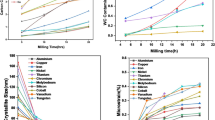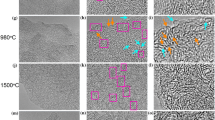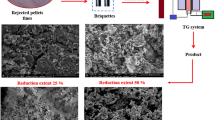Abstract
The ignition phenomena and the reaction mechanism of the self-propagating high-temperature synthesis reaction of titanium and carbon powders were experimentally investigated. When using coarse graphite powders (<325 mesh) as the carbon source, the ignition temperature ranged from 1650–1720‡C and was independent of the C/Ti ratio. The ignition temperature could be significantly lowered by using finer graphite powders (e.g. 1400‡C for <1 Μm powder). When using carbon black as the carbon source, the ignition temperature ranged from 1050–1475‡C and was dependent on the C/Ti ratio. The ignition was confirmed in this study to be controlled by the rate of the surface reaction between titanium and carbon which, in turn, was determined by the contact surface area between them. The fractured surfaces of the products showed two different types of morphology, i.e. groups of grains similar to sintered bodies and agglomerated fine particles. The relative quantities of the two types of morphology depended on the type of carbon used, the C/Ti ratio, the particle size of graphite and the density of the reactant pellet. Possible reaction mechanisms have been proposed on the basis of the experimental observations of the ignition phenomena and the product morphology.
Similar content being viewed by others
References
J. D. Walton and N. E. Poulos, J. Am. Ceram. Soc. 42 (1959) 40.
A. G. Merzhanov and I. P. Borovinskaya, Dokl. Akad. Nauk. SSSR (Chem.) 204 (1972) 366.
I. P. Borovinskaya, A. G. Merzhanov, N. P. Nov. Ikov and A. K. Filonenko, Combust. Explos. Shock Waves 10 (1974) 2.
A. G. Merzhanov, A. K. Filonenko and I. P. Borovinskaya, Dokl. Akad. Nauk. SSSR (Chem.) 208 (1973) 892.
A. G. Merzhanov, G. G. Karyuk, I. P. Borovinskaya, V. K. Prokudina and E. G. Dyad'ko, Sov. Powder Metall. Met. Ceram. 20 (1981) 709.
J. B. Holt and Z. A. Munir, J. Mater. Sci. 21 (1986) 251.
A. A. Zenin, A. G. Merzhanov and G. A. Nersisyan, Fiz. Goren. Vzryva 17 (1981) 63.
Z. A. Munir and J. B. Holt, J. Mater. Sci. 22 (1987) 710.
I. P. Borovinskaya and V. E. Loryan, Sov. Powder Metall. Met. Ceram. 191 (1979) 851.
T. M. Maksimov, M. K. Ziatdinov, A. G. Raskolenlo and O. K. Lepakova, Combust. Explos. Shock Waves 15 (1979) 415.
A. R. Sarkisyan, S. K. Dolukhanyan and I. P. Borovinskaya, Sov. Powder Metall. Met. Ceram. 17 (1978) 424.
K. A. Philpot, Z. A. Munir and J. B. Holt, J. Mater. Sci. 22 (1987) 159.
S. D. Dunmead, D. W. Readey, C. E. Semler and J. B. Holt, J. Am. Ceram. SoC. 72 (1989) 2318.
O. R. Bergmann and J. Barrington, ibid. 49 (1966) 502.
A. P. Hardt and P. V. Phund, Combust. Flame 21 (1973) 77.
A. P. Hardt and R. W. Holsinger, ibid. 21 (1973) 91.
V. O. Eramkov, A. G. Strunina and V. V. Barzykin, Combust. Explos. Shock Wave 12 (1976) 185.
S. C. Deevi, J. Mater. Sci. 26 (1991) 2662.
W. C. Lee and S. L. Chung, Int. J. Self-Propagat. High-Temp. Synth. 1(2) (1992) 211.
A. I. Kirdyashkin, Yu. M. Maksimov and E. A. Nekrasov, Fiz. Goren. Vzryva 17(4) (1981) 33.
S. Sarian, J. Appl. Phys. 39 (1968) 3305.
Idem, ibid. 39 (1968) 5036.
Idem, ibid. 40 (1969) 3515.
R. Pampuch, J. Lis and L. Stobierski, in “Combustion and Plasma Synthesis of High Temperature Materials”, edited by Z. A. Munir and J. B. Holt (VCH, New York, 1990) p. 211.
E. K. Storms, in “The Refractory Carbides”, edited by J. L. Margrave (Academic Press, New York, 1967) p. 3.
Author information
Authors and Affiliations
Rights and permissions
About this article
Cite this article
Lee, W.C., Chung, S.L. Ignition phenomena and reaction mechanisms of the self-propagating high-temperature synthesis reaction in the Ti+C system. Journal of Materials Science 30, 1487–1494 (1995). https://doi.org/10.1007/BF00375253
Received:
Accepted:
Published:
Issue Date:
DOI: https://doi.org/10.1007/BF00375253




